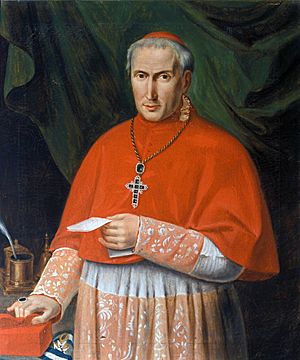Giacomo Giustiniani facts for kids
Quick facts for kids Giacomo Giustiniani |
|
|---|---|
| President of the Congregation of the Reverend Basilica of Saint Peter | |
 |
|
| Church | Catholic Church |
| Appointed | 1 July 1837 |
| Reign ended | 24 February 1843 |
| Predecessor | Pietro Francesco Galleffi |
| Successor | Mario Mattei |
| Other posts |
|
| Orders | |
| Ordination | 21 December 1816 |
| Consecration | 20 April 1817 by Alessandro Mattei |
| Created Cardinal | 2 October 1826 |
| Rank | Cardinal-Priest (1827–39) Cardinal-Bishop (1839–43) |
| Personal details | |
| Birth name | Giacomo Giustiniani |
| Born | 29 December 1769 Rome, Papal States |
| Died | 24 February 1843 (aged 73) Rome, Papal States |
| Buried | Santa Maria sopra Minerva |
| Parents | Benedetto Giustiniani Cecilia Carlotta Mahoni |
| Alma mater | La Sapienza University |
| Styles of Giacomo Giustiniani |
|
|---|---|
 |
|
| Reference style | His Eminence |
| Spoken style | Your Eminence |
| Informal style | Cardinal |
| See | Cardinal bishop of Albano |
Giacomo Giustiniani (1769–1843) was an important Italian religious leader. He served as a Cardinal and worked as a diplomat for the Pope. He was even considered a possible Pope himself in 1830. However, his election was stopped by the King of Spain.
Giacomo was the younger brother of Vincenzo Giustiniani, who was a prince.
Contents
Early Life and Priesthood
Giacomo Giustiniani was born in Rome, which was part of the Papal States at the time. This was on December 29, 1769. He came from a noble family.
His plans to become a priest were put on hold because of the Napoleonic Wars. These were major conflicts across Europe led by Napoleon Bonaparte. After the wars ended, he was finally ordained as a priest in 1816.
Becoming an Archbishop
In 1817, Giacomo Giustiniani became a papal nuncio. This means he was a special ambassador for the Pope. He served in Spain, representing the Pope's interests there.
During this time, he also became a titular archbishop of Tyre. A titular archbishop holds the title of an ancient diocese but does not govern a real church area.
Rise to Cardinal
Giacomo Giustiniani continued to advance in his church career. In 1826, he became the bishop of Imola, a city in Italy.
Later that same year, Pope Leo XII made him a Cardinal. Cardinals are high-ranking officials in the Catholic Church. They advise the Pope and can elect a new Pope.
Important Roles
In 1837, Cardinal Giustiniani took on a very important role. He became the Camerlengo. This position involves managing the Pope's finances and properties, especially when a Pope dies.
In 1839, he was appointed bishop of Albano. This is one of the seven "suburbicarian" dioceses near Rome. The cardinals who lead these dioceses are called Cardinal-Bishops.
Papal Conclave of 1830–31
After Pope Pius VIII died in 1830, cardinals gathered to elect a new Pope. This meeting is called a Papal Conclave. Giacomo Giustiniani was considered a strong candidate to become the next Pope.
However, King Ferdinand VII of Spain used his right to veto a candidate. This right, called jus exclusivae, allowed certain Catholic monarchs to block a papal election. Because of this veto, Giacomo Giustiniani could not become Pope.
Legacy
Cardinal Giacomo Giustiniani died on February 24, 1843, in Rome. He was buried in the Santa Maria sopra Minerva church. He is remembered for his long service to the Church and his diplomatic work.
See also
 In Spanish: Giacomo Giustiniani para niños
In Spanish: Giacomo Giustiniani para niños

